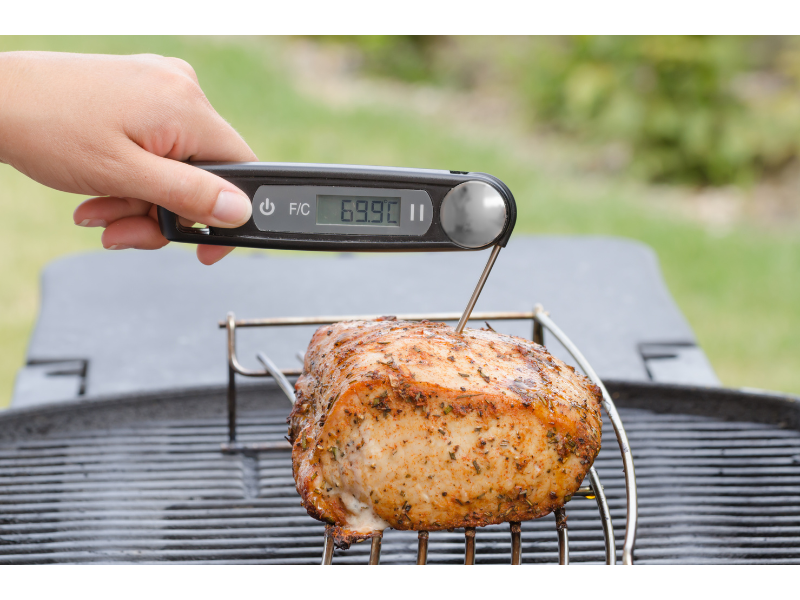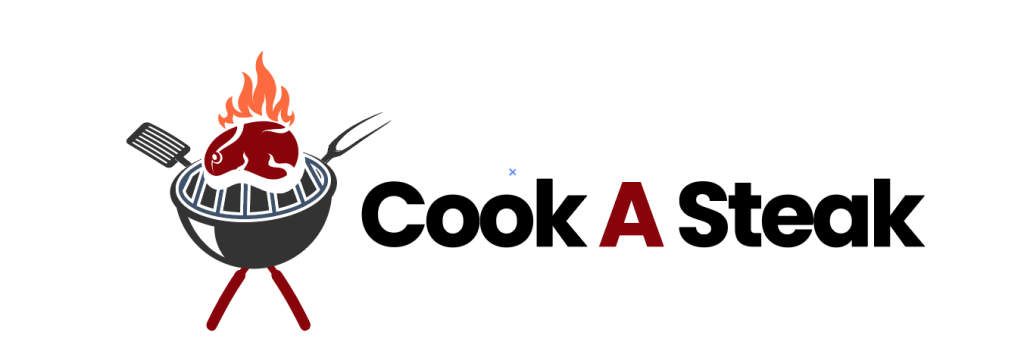
Ensuring food safety is paramount in any kitchen. A significant tool that aids in achieving this objective is the meat thermometer. This instructive guide will delve into how you can utilize a meat thermometer efficiently to ensure that your meat is cooked to a safe temperature, thereby preventing foodborne illnesses. Employing a meat thermometer is not just about culinary excellence but also about maintaining health and well-being.
Importance of Food Safety
Begin by recognizing the critical role that food safety plays. It is essential in safeguarding against foodborne illnesses, which can cause severe health issues. Food safety protocols, like proper cooking and handling of meat, are your primary defense against harmful pathogens such as Salmonella, E. coli, and Listeria. Cooking meat to the correct internal temperature kills these bacteria, making the food safe to consume. The use of a meat thermometer is integral to this process as it provides an accurate measurement of the meat’s internal temperature, ensuring it has reached a safe level.
Role of Meat Thermometers

Meat thermometers are indispensable tools in the kitchen. They provide a precise measurement of the internal temperature of the meat, ensuring it is cooked thoroughly. Visual cues alone, like the color or texture of the meat, are often unreliable in determining doneness. A meat thermometer eliminates this uncertainty by giving an exact reading. This precise measurement ensures that the meat is not undercooked, which could harbor pathogens, or overcooked, which could lead to dryness and loss of flavor. Using a meat thermometer demonstrates a commitment to both culinary quality and food safety.
Overview of Procedures
Understanding and following the proper procedures when using a meat thermometer ensures optimal results. The process begins with familiarizing yourself with food safety guidelines to know the recommended internal temperatures for different types of meat. Next, prepare your meat thermometer by ensuring it is clean and properly calibrated. During cooking, insert the thermometer into the thickest part of the meat, avoiding bones and fat, to get an accurate reading. Check the temperature at intervals to monitor progress. Once the meat reaches the desired temperature, allow it to rest, letting the juices redistribute and the temperature stabilize. Following these steps meticulously ensures your meat is cooked safely and is ready to be enjoyed.
Understanding Food Safety Guidelines
To ensure that the food you prepare is both delicious and safe, it is essential to understand and adhere to established food safety guidelines. These guidelines offer vital information on how to prevent foodborne illnesses, safeguard health, and ensure that your meals are cooked properly. Adhering to these protocols can make the difference between a safe, enjoyable meal and a potentially dangerous one.
USDA Recommendations
Educate yourself about the USDA’s safe minimum internal temperatures for different types of meat. These temperatures are set to ensure that all harmful bacteria are effectively destroyed, making the meat safe for consumption.
For various types of meat, different temperature guidelines apply:
- Poultry (including chicken and turkey) should reach an internal temperature of 165°F (74°C). This is essential because poultry is prone to harboring bacteria like Salmonella and Campylobacter.
- Ground meats such as beef, pork, veal, and lamb should be cooked to at least 160°F (71°C). Ground meats have a higher risk of contamination since the grinding process can mix bacteria throughout the meat.
- Whole cuts like steaks, roasts, and chops of beef, pork, veal, and lamb should reach an internal temperature of 145°F (63°C), followed by a rest time of three minutes. The resting period allows the temperature to even out and the meat fibers to reabsorb juices, enhancing flavor and safety.
These recommendations are based on scientific research and extensive testing aimed at minimizing the risk of foodborne illnesses.
Importance of Adhering to Guidelines
Strict adherence to these cooking temperature guidelines is crucial. Cooking meat to the correct internal temperature destroys pathogenic organisms such as Salmonella, E. coli, and Listeria, which can cause severe illnesses. Undercooking can result in food poisoning that manifests through symptoms like nausea, vomiting, diarrhea, and even more severe complications, particularly in vulnerable populations such as young children, the elderly, and those with compromised immune systems.
By following these guidelines, you ensure not only the safety of your food but also enhance its quality. Proper cooking leads to better texture, flavor, and overall dining experience. Thus, using a meat thermometer is not just a tool for safety; it’s an investment in the quality of your meals.
Regular Updates and Cross-Verification
It is vital to stay informed about the latest food safety guidelines and updates. Food safety standards can change based on new research, emerging pathogens, and improved understanding of foodborne risks.
Regularly visit reputable sources such as the USDA website or your local public health department’s resources. These sites provide the most current information and recommendations on safe food handling practices. Additionally, consider signing up for alerts or newsletters from these organizations to stay updated on any changes.
Cross-verifying information from multiple credible sources can also be beneficial. This practice ensures that you are following the most accurate and up-to-date guidelines, enhancing your ability to prepare safe and healthy meals.
Integrating this knowledge into your cooking routine not only contributes to the safety and health of those consuming your meals but also instills confidence and assurance that you are following best practices in food preparation.
Preparation and Use of Meat Thermometers
Cleaning and Calibrating
Start by ensuring that the meat thermometer is thoroughly cleaned before every use. To avoid cross-contamination, wash the probe with hot, soapy water and rinse it well. After washing, dry it completely with a clean towel. It is crucial to keep the thermometer sanitary, especially if it will be reinserted into the meat during the cooking process. Next, calibrate your thermometer to ensure its accuracy. This can be done using the ice-water method. Fill a glass with ice and top up with cold water, letting it sit for a couple of minutes. Insert the thermometer probe into the water, ensuring it does not touch the glass sides or bottom. It should read 32°F (0°C). If it does not, consult your thermometer’s manual to adjust it accordingly. Regular calibration of the thermometer ensures precise readings and better food safety.
Proper Usage Techniques
When using the meat thermometer, insert the probe into the thickest part of the meat. Avoid letting the probe touch bone or gristle, as these can conduct heat and give inaccurate temperature readings. For poultry, the thickest area is generally the thigh area, while for other meats, it could be the thickest section. Ensure the probe penetrates at least 1-2 inches deep to accurately measure the internal temperature. During insertion, hold the thermometer steadily and wait for the reading to stabilize. This may take several seconds, depending on whether your thermometer is digital or analog. Digital thermometers typically provide faster readings. By following these techniques, you maximize accuracy, ensuring food safety and proper doneness.
Reading and Interpreting Temperatures
To ensure the meat reaches the recommended internal temperature, monitor the thermometer closely. Refer to unique temperature guidelines for different meat types: for example, poultry should reach 165°F, ground meats 160°F, and roasts or steaks 145°F with a resting period. After achieving the desired temperature, remove the meat from heat. Proper interpretation of these readings affirms that potentially harmful bacteria are eradicated, making the food safe for consumption. Always double-check the final reading to ensure it aligns with safety recommendations. Consistent use and proper reading of a meat thermometer lead to better-tasting and safer meals.
Checking Doneness and Serving
Checking Doneness
Ensure that you monitor the internal temperature of the meat closely as it cooks. Using your meat thermometer, insert the probe into the thickest part of the meat, away from bone, fat, or gristle. Doing so will guarantee an accurate reading. Aim for the recommended internal temperatures outlined in food safety guidelines, such as 165°F for poultry and 145°F for roasts, steaks, and chops. Remove the meat from heat immediately once these temperatures are attained. This method reduces any risk of undercooking, which can lead to harmful bacterial survival.
Resting Meat
After cooking, allow the meat to rest for a specified period, typically between 3 to 10 minutes, depending on the size and type of meat. This resting period is crucial as it helps the meat retain moisture, resulting in juicier, more flavorful servings. Additionally, the rest time allows the internal temperature to even out, ensuring the meat is fully cooked. Avoid cutting into the meat immediately after cooking, as this can cause the juices, which contain much of the flavor, to escape.
Serving Safely
When you are ready to serve, ensure that all serving plates and utensils are clean to prevent contamination. Transfer the cooked meat onto a clean serving platter with clean utensils, avoiding any contact with surfaces that may have been exposed to raw meat. This precaution helps to eliminate the risk of cross-contamination, which can lead to foodborne illnesses. Present the meat attractively on the serving platter, slicing it carefully if needed. Serve the meat along with appropriately handled side dishes, ensuring every aspect of the meal adheres to food safety standards.
In conclusion, following these final steps diligently will ensure that your meat preparations are both safe and delicious. This methodical approach—checking doneness with a meat thermometer, allowing resting time, and serving safely—provides a comprehensive framework for food safety. Adhering to these precautions not only enhances the flavor and texture of the meat but also minimizes any health risks, ensuring a satisfying and safe dining experience.
